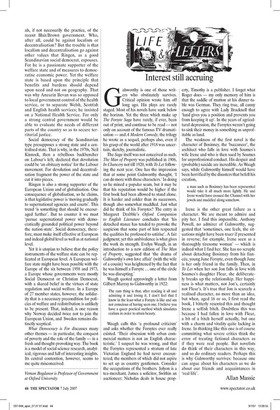Interest still accruing
Galsworthy is one of those writers who obstinately survives. Critical opinion wrote him off long ago. His plays are rarely staged. Most of his novels have sunk below the horizon. Yet the three which make up The Forsyte Saga have rarely, if ever, been out of print, and continue to be read — not only on account of the famous TV dramatisation — andA Modern Comedy, the trilogy he wrote as a sequel, perhaps also, even if his grasp of the world after 1918 was uncertain, sketchy, journalistic.
The Saga itself was not conceived as such. The Man of Property was published in 1906, In Chancery not till 1920, with To Let following the next year. One has the impression that at some point Galsworthy thought, 'I can do more with these characters.' In doing so he mined a popular seam, but it may be that his reputation would be higher if the first book had been allowed to stand alone. It is harder and colder than its successors, though also somewhat muddled. Just what did he think of his Forsytes? The entry in Margaret Drabble's Oxford Companion to English Literature concludes that 'his detached stance has tended to provoke the suspicion that some part of him respected the qualities he professed to satirise'. A fair judgment; yet this ambivalence is what gives the work its strength. Evelyn Waugh, in an introduction to a new edition of The Man of Property, suggested that `the drama of Galsworthy's own love affair' (with the wife of a cousin) 'was heightened by the fact that he was himself a Forsyte ... one of the circle he was disrupting.'
Waugh quoted approvingly a letter from Gilbert Murray to Galsworthy in 1922: The rum thing is that, after reading it all and admiring it and loving it, I don't feel that I know in the least what a Forsyte is like and am not conscious of having seen one. I believe you have a queer poetical method which simulates realism in order to attain beauty.
Waugh calls this 'a profound criticism' and asks whether the Forsytes ever really existed. 'Their obsession with urban commercial matters is not an English characteristic.' I suspect he was wrong, and that the Forsytes represented a stratum of late Victorian England he had never encountered, the members of which did not aspire to set up as country gentlemen. Consider the occupations of the brothers. Jolyon is a tea-merchant, James a solicitor, Swithin an auctioneer; Nicholas deals in house property, Timothy is a publisher. I forget what Roger does — my only memory of him is that the saddle of mutton at his dinner-table was German. They ring true, all canny enough to agree with Lady Bracknell that 'land gives you a position and prevents you from keeping it up'. In the years of agricultural depression, the Forsytes weren't going to sink their money in something as unprofitable as land.
The weakness of the first novel is the character of Bosinney, the 'buccaneer', the architect who falls in love with Soames's wife Irene and who is then sued by Soames for unprofessional conduct. His despair and (probable) suicide are incredible. As Waugh says, while Galsworthy himself would have been horrified by the disasters that befell his creation, a man such as Bosinney has been represented would take it all much more lightly. He and Irene would have crossed the Channel with her jewels and muddled along somehow.
Irene is the other great failure as a character. We are meant to admire and pity her. I find this impossible. Anthony Powell, no admirer of Galsworthy, suggested that 'sometimes, one feels, the situations might have been truer if presented in reverse; for example, Irene seen as a thoroughly tiresome woman' — which is indeed what I find her. She has no scruple about detaching Bosinney from his fiancée, young June Forsyte, even though June is her only friend in the family. Then, in To Let when her son Jon falls in love with Soames's daughter Fleur, she deliberately breaks up the relationship. Her happiness is what matters, not Jon's, certainly not Fleur's. It's true that Jon is scarcely a realised character, no more than an idea, but when, aged 16 or so, I first read the book, I bitterly resented this and thought Irene a selfish bitch. Doubtless this was because I had fallen in love with Fleur, a bit of a bitch herself actually, but one with a charm and vitality quite lacking in Irene. In thinking like this one is of course committing what severe critics think the error of treating fictional characters as if they were real people. But novelists do think of their characters in this way, and so do ordinary readers. Perhaps this is why Galsworthy survives: because one can argue about his characters as we do about our friends and acquaintances in 'real life'.
Allan Massie



















































 Previous page
Previous page